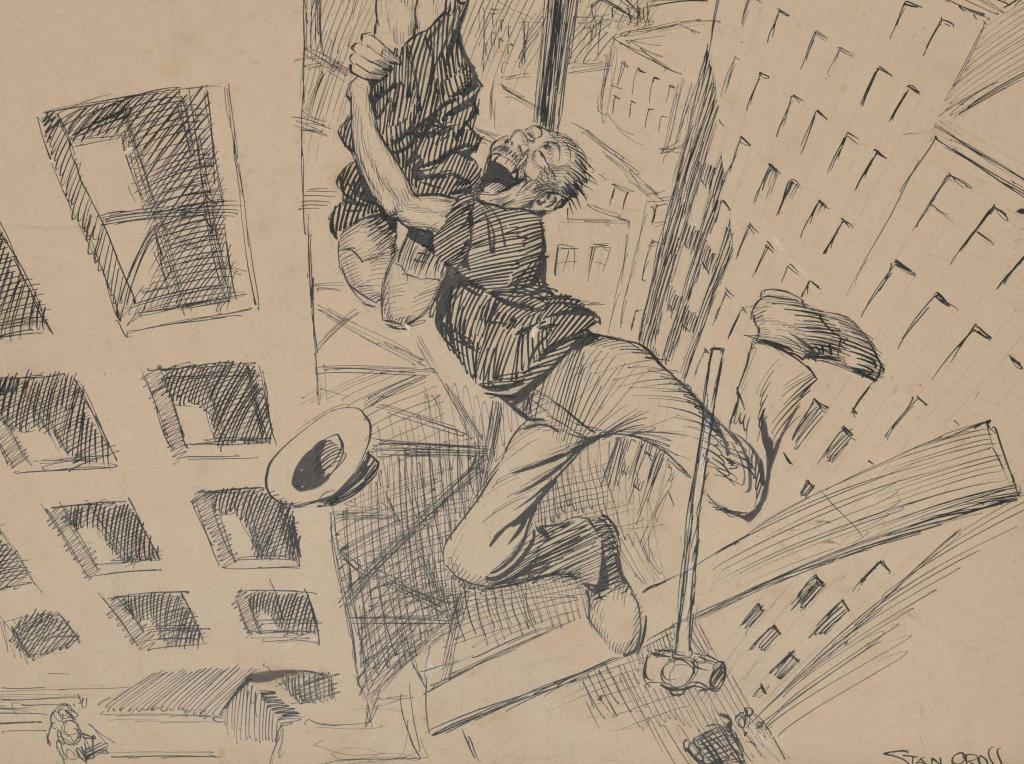Stan Cross, For gorsake stop laughing – this is serious! (detail). Image courtesy National Library of Australia.
Inked: Australian Cartoons is an exhibition from the National Library of Australia (NLA) that showcases the history of cartooning in Australia. The exhibition travels from the 1780s to the present, drawing from the NLA’s collection of over 14,000 cartoons.
The collection – painstakingly curated by Director of Exhibitions Dr Guy Hansen – provides a series of snapshots of major Australian events, social movements and personalities, particularly political leaders, as portrayed and interpreted by our cartoonists.
Hansen said of cartoons that, ‘like the work of filmmakers, writers and journalists, they hold up a mirror to Australia and invite us to reflect on what is going on in our society.’
One of the most iconic cartoons featured in the exhibition is For gorsake, stop laughing – this is serious! by Stan Cross. You’ll recognise the image of two men hanging from a girder, one of them with his pants around his ankles and both laughing uproariously despite their grim situation. The cartoon, drawn in 1933, exemplified laughing in the face of adversity, a powerful metaphor at the height of the Great Depression.
The exhibition specifically covers editorial cartoons, pocket cartoons and editorial illustrations. Hansen acknowledged that comic books and strips are an important part of popular culture, but these are not included in the exhibition’s scope. He said, ‘The collections include examples of satirical hand-coloured prints that sold from print shops in London in the 1780s, satirical drawings done by early settlers, cartoons prepared for colonial publications such as Punch and The Bulletin, as well as numerous examples of artwork from major newspapers and magazines in the 20th century.’
Artists include Will Dyson, Judy Horacek, Michael Leunig, David Low, Phil May, Alan Moir, Bruce Petty, Martin Sharp, and Cathy Wilcox. Inked neatly breaks into sections titled Botany Bay, Australia, War, Leaders, New Voices and 21st Century, charting how Australian cartooning has changed over the last 200+ years. Although cartoonists’ focus shifts and changes during the different periods, the devastating humour and insightful social commentary is consistent throughout the collection.
Hansen acknowledged that Inked is not a comprehensive collection of all Australian cartoonists, and indeed this would be an impossible task given the space. However, representation of Indigenous Australians is limited to subject matter, and only a handful of female cartoonists are included.
This imbalance could have been addressed by the inclusion of Indigenous artist Danny Eastwood (cartoonist for the Koori Mail and National NAIDOC Aboriginal Artist of the Year in 1993) and more female artists such as Walkley award winner Jenny Coopes and Fiona Katauskas.
Inked: Australian Cartoons, however, is not limited to the print medium, and this serves to increase opportunities for engagement with the rich catalogue of work. On loan from the National Museum of Australia are a range of items including an animated film and dioramas by Michael Leunig, sculptures by Peter Nicholson (Rubbery Figures), John Shakespeare (The Dismissal) and Bruce Petty (Law Machine), and a smock presented to that icon-sketcher Stan Cross.
There is also a dedicated play space called Inked Play, which has been curated specifically for families and children. Children engage with cartoons through drawing, reading and searching for Inkie the Echidna, who appears throughout the exhibition on child-friendly artwork labels. A fun way to open a landmark exhibition up to all ages.
4 stars out of 5 ★★★★
Inked: Australian Cartoons
7 March-21 July 2019
National Library of Australia ACT
Free admission





